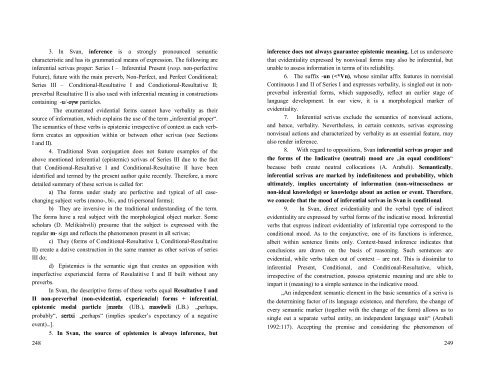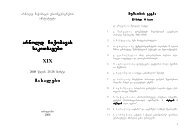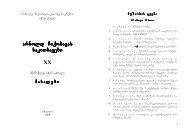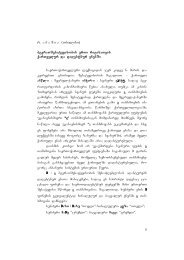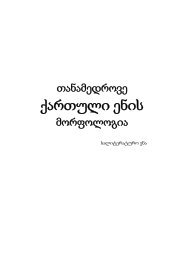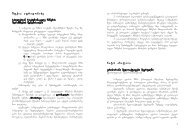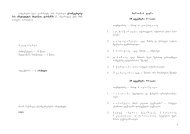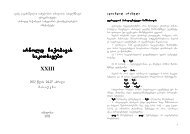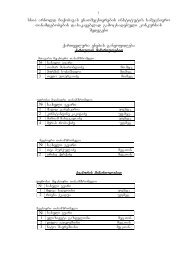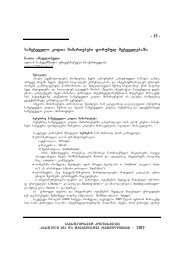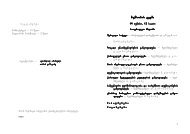fwjefodjbmpcjt!lbufhpsjb! twbovs!fobTj
fwjefodjbmpcjt!lbufhpsjb! twbovs!fobTj
fwjefodjbmpcjt!lbufhpsjb! twbovs!fobTj
You also want an ePaper? Increase the reach of your titles
YUMPU automatically turns print PDFs into web optimized ePapers that Google loves.
3. In Svan, inference is a strongly pronounced semantic<br />
characteristic and has its grammatical means of expression. The following are<br />
inferential scrivas proper: Series I – Inferential Present (resp. non-perfective<br />
Future), future with the main preverb, Non-Perfect, and Perfect Conditional;<br />
Series III – Conditional-Resultative I and Condiotional-Resultative II;<br />
preverbal Resultative II is also used with inferential meaning in constructions<br />
containing -u/-oG… particles.<br />
The enumerated evidential forms cannot have verbality as their<br />
source of information, which explains the use of the term „inferential proper“.<br />
The semantics of these verbs is epistemic irrespective of context as each verbform<br />
creates an opposition within or between other scrivas (see Sections<br />
I and II).<br />
4. Traditional Svan conjugation does not feature examples of the<br />
above mentioned inferential (epistemic) scrivas of Series III due to the fact<br />
that Conditional-Resultative I and Conditional-Resultative II have been<br />
identified and termed by the present author quite recently. Therefore, a more<br />
detailed summary of these scrivas is called for:<br />
a) The forms under study are perfective and typical of all casechanging<br />
subject verbs (mono-, bi-, and tri-personal forms);<br />
b) They are inversive in the traditional understanding of the term.<br />
The forms have a real subject with the morphological object marker. Some<br />
scholars (D. Melikishvili) presume that the subject is expressed with the<br />
regular m- sign and reflects the phenomenon present in all scrivas;<br />
c) They (forms of Conditional-Resultative I, Conditional-Resultative<br />
II) create a dative construction in the same manner as other scrivas of series<br />
III do;<br />
d) Epistemics is the semantic sign that creates an opposition with<br />
imperfective experiencial forms of Resulatitive I and II built without any<br />
preverbs.<br />
In Svan, the descriptive forms of these verbs equal Resultative I and<br />
II non-preverbal (non-evidential, experiencial) forms + inferential,<br />
epistemic modal particle [mˆrŠs (UB.), ma…S…li (LB.) „perhaps,<br />
probably“, serTxi „perhaps“ (implies speaker’s expectancy of a negative<br />
event)...].<br />
248<br />
5. In Svan, the source of epistemics is always inference, but<br />
inference does not always guarantee epistemic meaning. Let us underscore<br />
that evidentiality expressed by nonvisual forms may also be inferential, but<br />
unable to assess information in terms of its reliability.<br />
6. The suffix -un (


